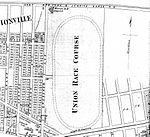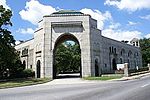Dexter Park (Queens)
1955 disestablishments in New York (state)Baseball venues in New York CityDefunct baseball venues in the United StatesDefunct horse racing venues in New York CityDemolished sports venues in New York (state) ... and 3 more
Former sports venues in New York CitySports venues in Queens, New YorkWoodhaven, Queens
Dexter Park was a public park located in the neighborhood of Woodhaven, Queens, New York City, just north of Eldert Lane and Jamaica Avenue, not far from the borough line with Brooklyn. It had a long early history starting in the 19th century as a recreational park, which replaced a racetrack.
Excerpt from the Wikipedia article Dexter Park (Queens) (License: CC BY-SA 3.0, Authors).Dexter Park (Queens)
85th Drive, New York Queens
Geographical coordinates (GPS) Address Nearby Places Show on map
Geographical coordinates (GPS)
| Latitude | Longitude |
|---|---|
| N 40.693611111111 ° | E -73.8675 ° |
Address
85th Drive 74-23
11421 New York, Queens
New York, United States
Open on Google Maps









